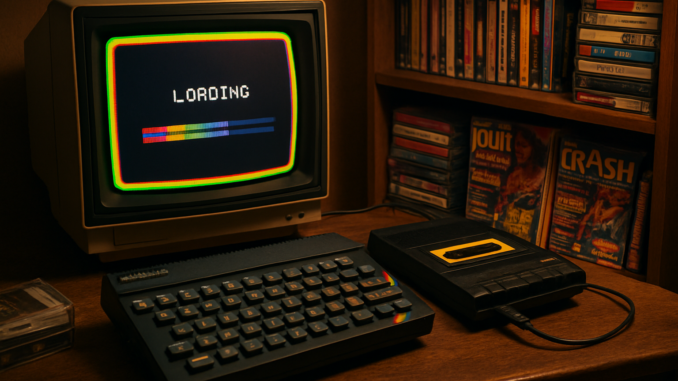
There was a time when gaming wasn’t about instant gratification — it was about patience, faith, and the hopeful whirr of a cassette deck.
If you grew up in Britain during the 1980s, chances are you remember the ritual: carefully slotting a worn cassette into a battered tape player, typing LOAD "", and sitting nervously through a screeching, warbling chorus that seemed to last forever.
Sometimes, it worked. Sometimes, the screen stayed stubbornly blank. But every loading session felt like a tiny act of hope.
Today, downloads happen in seconds. Games stream to phones with barely a thought. But in the age of cassette gaming, waiting was part of the adventure — a defining cassette gaming ritual — and in a way, it made the experience all the more magical.
Let’s rewind and take a look at why those screechy rituals still resonate — and what we might have lost when we left them behind.
The Origins of Cassette Loading
In Britain’s early home computing boom, affordability was everything.
Unlike the expensive floppy drives gaining traction in the US, British systems like the ZX Spectrum, BBC Micro, and Amstrad CPC embraced the humble cassette tape. Cheap, familiar, and already in every living room thanks to Top 40 mixtapes, cassettes became the natural medium for early computer software.
Loading software from tape was both brilliantly simple and frustratingly fragile.
When you typed LOAD "" (or variations like CHAIN on the BBC Micro), the computer switched into listening mode, treating audio signals as streams of data. A good quality tape might load a game in a few minutes. A scratched, dusty cassette? You might be sitting there for half an hour, praying it wouldn’t crash at the final block.
Magazines like Your Sinclair and Crash turned the cassette into a cultural icon, bundling demo tapes on their covers that readers would eagerly tear off and load — often after multiple tries.
It wasn’t just a loading process. It was a rite of passage.
The Peak of the Ritual
Saturday mornings at Maplin or WHSmith were a sensory overload: the tang of fresh ink from game inlays, the clatter of plastic cases, and walls lined with cassettes promising pixelated worlds beyond imagination.
You didn’t just buy a game — you bought the dream that it would load.
Sometimes you’d press play, and the telltale loading screen would begin to shimmer into view — if you were lucky. Games from publishers like Ocean Software even included animated loading screens (“Ocean Loaders”) that teased players with tantalising glimpses of what was to come.
There was nothing quite like the slow reveal of rainbow lines and distorted music while the tape whirred on. For many, it was the ultimate test of patience: sitting stock-still, terrified that bumping the machine would cause a catastrophic R Tape Loading Error.
Some friends developed elaborate superstitions — always placing the tape deck on a tea towel, or never rewinding more than twice — as if appeasing the gods of magnetic media. Meanwhile, while waiting anxiously, you might even check Ceefax for the weather, hoping your forecast (and your game) would load without a hitch.
The rituals didn’t end there.
Tapes were traded in playgrounds, copied between friends (sometimes with hand-written instructions scrawled in biro on battered labels), and even archived on lovingly catalogued C90 mixtapes, mixing favourite games with chart hits.
It was messy. It was frustrating. It was utterly magical.
(And today, there’s a new wave of interest through modern ZX Spectrum preservation efforts — a testament to the ritual’s lasting grip.)
Why Tapes Were So Fussy
Cassettes stored computer software as analogue audio signals.
Think of it like recording digital data as a weird kind of music.
If the tape was worn, dirty, or the playback head was misaligned, the computer would misinterpret the signal — resulting in crashes, corrupted graphics, or the dreaded “Loading Error” screens.
Factors like tape speed, volume settings, and even background radio interference could cause havoc.
It was a delicate dance of precision — and pure luck.
From Patience to Instant Gratification
Fast forward to 2025, and the notion of waiting for a game to load feels almost alien.
Downloading a 40GB open-world epic from the cloud? Barely time for a cup of tea.
Game streaming services like GeForce NOW or Xbox Cloud Gaming mean entire libraries are playable with a tap.
Speed is wonderful — but something subtle may have been lost along the way.
Back in the cassette days, the wait heightened the experience.
The act of loading created a natural sense of anticipation and investment. When you finally saw that pixelated title screen blink into life, it meant something.
It was the culmination of hope, patience, and a little bit of magic.
There’s no denying that instant access is a marvel of modern tech.
But the rituals of old forced us to slow down, to savour the build-up.
They gave software a kind of tactile, living presence — one where success wasn’t guaranteed, and each triumph felt earned.
Perhaps that’s why, even today, there’s a growing community dedicated to preserving old loading tapes, repairing vintage hardware, and reliving those moments when gaming was a ceremony, not a service.
Conclusion: The Magic in the Wait
The screech of a loading tape is a sound etched deep into the memories of a generation — chaotic, messy, hopeful.
It taught us patience. It taught us resilience. It taught us that sometimes, the journey to getting what you want is the experience.
And perhaps, in an era where everything is a tap away, remembering how it felt to wait for magic isn’t such a bad thing.
Do you remember your longest cassette loading wait? Did it succeed — or end in heartbreak?
Share your stories with us below!

Leave a Reply